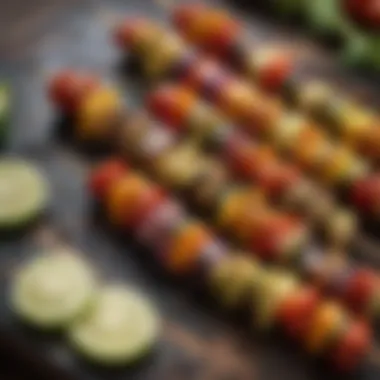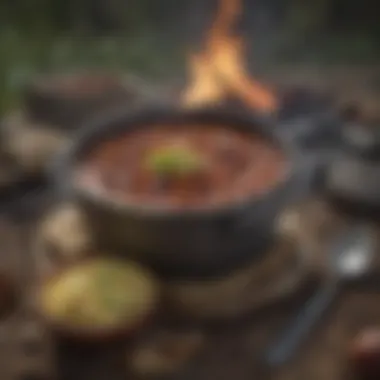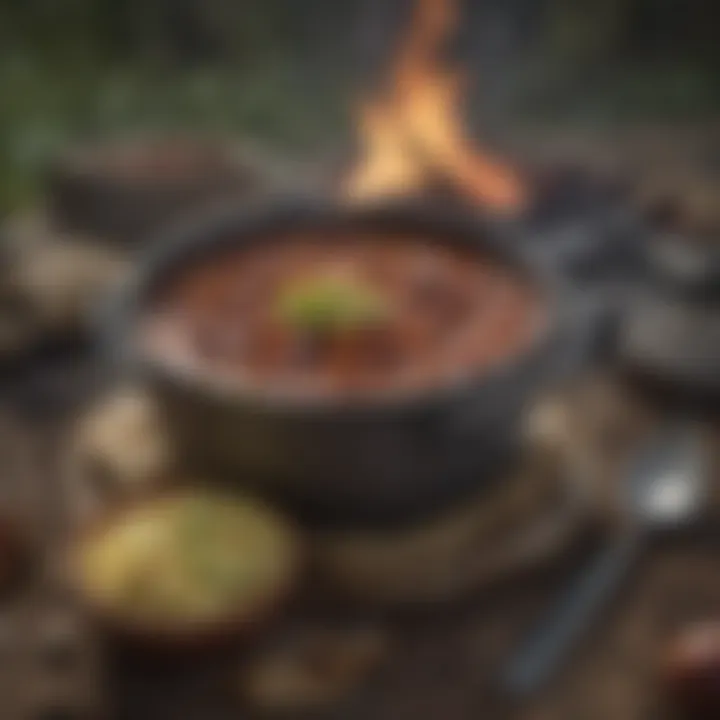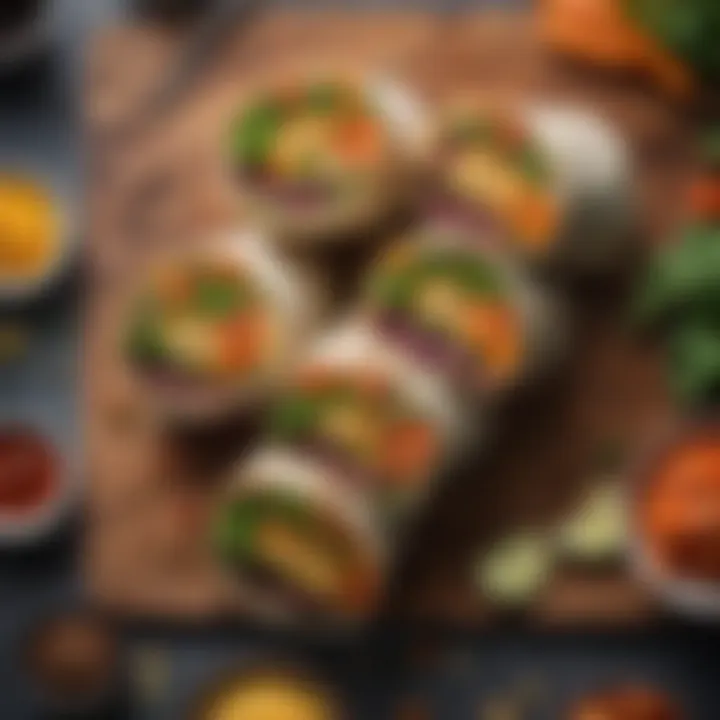Delicious Vegan Recipes for Your Camping Trip


Intro
Camping and cooking may seem like an odd couple, especially for vegans who wish to embrace the great outdoors. However, escaping to nature doesn't mean sacrificing flavor or nutrition. In fact, with a little bit of creativity and preparation, the possibilities are endless. This guide will equip you with a plethora of vegan recipes designed for the camping connoisseur, ensuring that your culinary experience remains delightful throughout your adventure.
We dive into practical aspects that address challenges faced when cooking outdoors, ranging from ingredient selection to preparation methods. The aim is to empower you to whip up delicious, hearty meals that sustain both energy and spirit in the wild.
So, roll up your sleeves, grab that portable stove, and let’s embark on this culinary journey among the trees, under the stars, and by the riverside. You'll discover that preparing vegan meals while camping can indeed be an enjoyable affair, rich with flavors and nutrients.
Recipe Overview
Spice-Up Veggie Skewers
Portions: 4
Prep Time: 15 minutes
Cook Time: 15 minutes
Difficulty: Easy
Main Ingredients
- Bell peppers
- Zucchini
- Mushrooms
- Cherry tomatoes
- Olive oil
- Your favorite spices
Step-by-Step Instructions
- Prepare the Ingredients:
- Bring it all Together:
- Skewer Time:
- Cook on the Grill:
- Begin by washing and cutting the bell peppers and zucchini into bite-sized chunks.
- Clean the mushrooms and leave the cherry tomatoes whole.
- In a large bowl, toss the chopped veggies together. Drizzle with olive oil and sprinkle your favorite spices. Consider classic choices like garlic powder, paprika, or a touch of chili powder for an extra kick.
- Thread the marinated veggies onto skewers, alternating the colors for a stunning look.
- Over the campfire or on a portable grill, cook the skewers for about 15 minutes, turning occasionally until the vegetables are tender and slightly charred.
Time-Saving Strategies
- Pre-chop veggies at home to save time.
- Use metal skewers instead of wood to avoid soaking.
Nutritional Information
- Calories: 150 per portion
- Protein: 2g
- Fat: 8g
- Carbohydrates: 18g
This recipe is not only low in calories but also high in vitamins and minerals, thanks to the variety of vegetables used. The olive oil contributes healthy fats, making it a balanced choice for a camping meal.
Quick Cooking Tips
- Gadget Helpers:
While you may be camping, don’t shy away from using a portable stovetop or a small grill. - Multitasking:
While waiting for your skewers to cook, why not prep a side salad or prepare a simple vegan dip with any leftover veggies? - Healthier Alternatives:
Swap olive oil for a spray oil for controlled distribution. It cuts down on calories without sacrificing flavor.
Related Recipes & Variations
- Herbed Quinoa Salad - A perfect side dish that can be made in advance and served cold.
- Creamy Hummus Dip - Enjoy with leftover veggies or pita bread.
Consider adding different spices, or using zucchini instead of bell peppers if you prefer. Don't hesitate to make it your own and share how you personalize it!
Intro to Vegan Camping Recipes
When it comes to camping, the often rough and tumble nature of outdoor life can throw a wrench into one’s meal planning. For vegans, this challenge can feel even more pronounced. Not only are there constraints on what to pack, but the need for taste, nutrition, and convenience is of utmost importance. Understanding how to navigate this terrain is crucial for making the most of the experience while enjoying satisfying vegan meals under the stars.
Vegan camping recipes are not just about avoiding meat and dairy. It's a culinary adventure that encourages creativity, simplicity, and healthy eating. Not to mention, it allows you to connect with the environment and make the most of fresh ingredients that you can often find right where you are. Cooking outdoors can elevate your meals in more ways than one, turning tradition on its head while fostering a sense of community with fellow campers.
Understanding Veganism in Outdoor Settings
Veganism thrives on variety and flavor, but what works in a fully stocked kitchen may not cut it in nature. For instance, the need to incorporate local, seasonal produce is heightened when camping. Farmers’ markets or community farms can be a cornucopia of potential ingredients if the timing’s right. Not only does this promote a sustainable lifestyle, but it also enhances the taste of the dishes.
The beauty of vegan camping lies in utilizing nature's bounty. Ingredients like wild berries, edible flowers, roots, and greens can pack your meals with both flavors and nutrients.
However, it’s important to be knowledgeable about what you can forage and what you should steer clear of. A little research can go a long way.
The Importance of Planning
Planning is your best friend when embarking on a camping trip, especially if vegan meals are on the menu.
Consider the Following Aspects When Planning:
- Meal Diversity: Think about a mix of meals: breakfasts, lunches, dinners, and snacks. A well-rounded approach can keep boredom at bay.
- Cooking Equipment: Identify what you have access to while camping. Do you have a portable stove or are you relying on campfire cooking? Each option requires different ingredients and methods.
- Ingredient Availability: Take into account what can be easily carried, as well as what can spoil. Picking non-perishable items like lentils, rice, nuts, and dehydrated foods is key.
- Time Management: Make sure to plan meals that don’t require long prep times, as you might be managing post-hike exhaustion or setting up camp.
Planning isn’t just about logistics; it's about setting the stage for an enjoyable outdoor experience. By being well-prepared, you can avoid the frustration of scrounging together a meal from an empty food pack, leaving you free to relax and soak in the beauty around you.
Ingredients for Vegan Camping
When it comes to camping, your culinary experience can be as enriching as the landscapes you explore. But what goes into creating those delightful meals? Selecting the right ingredients for vegan camping is crucial, not just for flavor but also for practicality and nutrition. Ensuring that your meals are both satisfying and energizing will help you enjoy your outdoor adventures to the fullest.
Camping is often marked by limited resources, so careful consideration of what you bring can make or break your food experience. Plant-based eating can present unique challenges; however, these challenges can transform into an opportunity to explore diverse ingredients that are easy to pack yet flavorful. Knowing how to balance non-perishable items with fresh produce can be the secret sauce behind a successful camping trip.
Here’s a close-up on how to gather a well-rounded ingredient list that meets the demands of both nourishment and convenience.
Selecting Non-Perishable Items
Non-perishable items are the backbone of any camping meal plan. They stand the test of time without refrigeration and can ensure you have enough sustenance throughout your stay in the wild. Think along the lines of grains, nuts, seeds, and legumes. Here are some smart choices:
- Quinoa: A complete protein, easy to cook, and gluten-free.
- Dried beans: Versatile and hearty, beans can be used in salads, wraps, and stews.
- Oats: Perfect for breakfast, and they can be mixed with spices or fruits.
- Nuts and seeds: Provide healthy fats and proteins, and they make great snacks.
- Nut butter: Consider bringing almond or peanut butter for easy energy boosts.
- Shelf-stable plant-based milk: This can add creaminess to beverages and meals.


These choices don’t just fill you up; they also pack complex carbohydrates that release energy slowly — the ideal energy source for hiking or exploring.
Choosing Fresh Produce
Bringing fresh produce along does require some forethought because they can spoil quickly. However, they can elevate your meals to a new level. Here are a few considerations to keep in mind:
- Hardy vegetables: Carrots, bell peppers, and cucumbers last longer and make great additions to salads or sandwiches.
- Seasonal fruits: Apples and oranges are sturdy options that travel well,
- Potatoes and sweet potatoes: These can be seasoned and roasted over a campfire or camp stove while being filling.
- Avocados: If you only buy them just ripe, they can be a great addition to wraps and sandwiches.
Don’t forget that fresh produce can also add vital vitamins and minerals to your meals, enriching your diet while you connect with nature.
Essential Spice and Condiment List
Spices and condiments might not make up the bulk of your ingredients, but they can change the whole canvas of your meals. A well-thought-out selection can bridge the gap between bland and flavorful. Here’s what you should consider packing:
- Salt and pepper: The basics, but essential.
- Garlic powder and onion powder: Great for adding depth to any dish.
- Cumin and paprika: Ideal for that earthy flavor for your chili or stews.
- Chili flakes or fresh chili: A dash can amp up any dish.
- Soy sauce or tamari: Perfect for creating umami-rich stir fries or dressings.
- Vegan mayonnaise and mustard: They can add creaminess and tang to sandwiches.
Adjusting your meals with the right spices not only keeps things interesting but ensures you've got comfort and flavor at your fingertips. By planning wisely and being conscious of your ingredient choices, you set yourself up for a successful and delightful vegan camping experience.
"The right ingredients can turn a simple meal into an unforgettable experience under the stars."
By understanding the importance of these categories and choosing wisely, you can navigate the sometimes tricky waters of cooking vegan while camping. So, pack smart, eat well, and savor every bite amidst nature.
Key Cooking Equipment for Camping
When you're out in the wild, cooking is not merely about feeding yourself—it's about the whole experience. You need to ensure that your key cooking equipment for camping gets the job done effectively while being practical to carry. Here, we explore why it’s vital to have the right tools at your disposal, highlighting various elements and benefits that are worth considering. Having a well-thought-out selection of equipment can make or break your culinary adventure, influencing everything from meal preparation to clean-up.
Portable Cooking Tools
Portable cooking tools are the backbone of any successful camping trip. They should be lightweight and multifunctional, allowing space-saving and versatility. Pack a trusty camping stove; it is not just for boiling water. Think of the ability to sauté veggies or simmer a soup while keeping everything contained in one compact unit.
Consider including a compact grill for those who enjoy the smoky flavor of grilled food, especially for veggies or plant-based patties. Look for a grill that’s easy to set up and clean. Having a good knife also cannot be overstated. A high-quality knife makes food prep quick, allowing you to chop, slice, and dice efficiently without fuss.
- Collapsible cutting boards can also save space while giving you a firm surface to work on.
- Don’t forget utensils—a sturdy spatula, a ladle, and a pair of tongs are essential for stirring, flipping, and serving.
- Last but not least, a lighter or waterproof matches for those campfire moments is key!
Camping Cookware Essentials
Not all cookware is created equal, especially when it comes to camping. You want pots and pans that are durable but also lightweight. There are some excellent non-stick options out there designed for camping. Look for set that offers a combination of size and functionality; a couple of pots or a frying pan will usually suffice.
Having a kettle for boiling water can be a game-changer—it's not just for tea! You can also use it for cooking grains like quinoa or couscous. Mixing bowls can be handy too, especially if they're collapsible.
If you're on a longer camping trip, consider items like a food dehydrator to prepare snacks for the trail or a reusable silicone food bag for storage. These are eco-friendly and work wonders for reducing waste.
"The right camping cookware can turn an average meal into a delightful experience in the great outdoors."
Making the Most of a Campfire
A campfire can be more than just a source of warmth; it's also the original cooking appliance. To truly make the most of it, learn to embrace various cooking methods that rely on fire. Grilling, roasting, and even cooking in cast iron can lend unique flavors to your dishes that's hard to replicate with a modern stove.
Invest in a cast iron skillet and a grill grate designed for campfires. Cast iron is legendary—even if it's slightly heavier, it lasts longer and distributes heat more evenly.
You could also explore the art of cooking in foil, which is simple and mess-free. Just wrap your veggies, grains, and spices in aluminum foil, toss it on the embers, and let the fire do its magic!
Furthermore, a fire pit allows you to control your campfire experience, making it easier to cook without endless logs and smoke. Keeping your fire small and controllable is not just wise for efficiency but also for safety.
Overall, take time to familiarize yourself with your equipment before hitting the trail. Doing a little preparation can lead to delicious outcomes and unforgettable camping memories.
Simple Breakfast Options
Starting the day off on the right foot is crucial, especially when you're out in the wild. A wholesome breakfast can energize campers and set the tone for a day filled with adventure. When considering vegan recipes for breakfast, it’s important to focus on elements like nutrient density, ease of preparation, and enjoyment of flavors. Simple breakfast options not only provide the necessary fuel but also adhere to the principles of healthy eating, making them essential in a camping context.
Overnight Oats Variations
Overnight oats are a game changer for camping breakfast. Prepare them the night before, and voilà! You’ve got a meal waiting for you when morning hits. The beauty of overnight oats lies in their flexibility. You can mix and match ingredients to suit your taste or whatever you have on hand. A basic recipe could involve rolled oats soaked in your favorite plant-based milk. From there, you might add:
- Chia seeds for added fiber
- Fresh fruits like berries or bananas for sweetness
- Nuts or nut butters for healthy fats
- A drizzle of maple syrup or agave for an extra kick
Feel free to get creative based on the season. In winter, warm cinnamon and baked apples can cozy up your oats, while in summer, fresh peaches or tropical fruits can keep things light and refreshing. Make sure to pack them in jars that seal well; nobody enjoys a spill on their gear.
Vegan Breakfast Burritos
Another super simple and satisfying option is the vegan breakfast burrito. This dish takes limited cooking time and can be customized to fit your preferences. Start with a whole-grain tortilla; it holds everything together, and you can fill it with a variety of ingredients, such as:
- Scrambled tofu seasoned with turmeric and cumin, mimicking eggs
- Black beans or pinto beans for extra protein
- Avocado slices for creaminess
- Any sautéed veggies, like bell peppers or spinach, for color and nutrients
Make each burrito, wrap it tightly in foil, and toss it on a grill or campfire for a few minutes to warm it through. It’s a portable breakfast that tastes great and can even be eaten on the go if your camping activities demand a quick start.
Fruit and Nut Energy Bars
Fruit and nut energy bars are perfect for those who prefer a breakfast that’s more snack-like. They can be made ahead of time and stored in your cooler or backpack to munch on as you hike. To whip up a batch, combine:
- Medjool dates as a base for sweetness and stickiness
- A selection of nuts like almonds, walnuts, or cashews for crunch
- Dried fruits, such as cranberries or apricots, for additional flavor
- Rolled oats or coconut flakes to bind it all together
Simply blend these ingredients in a food processor until well mixed. Press the mixture into a pan and refrigerate until it firms up. Cut it into bars or squares. These energy bites are chewy, delicious, and packed with sustenance to keep you going through explorations.
Feel free to experiment with flavors and textures.
Remember, a good breakfast fuels both body and spirit, making it essential to your camping experience.
By opting for simple, delicious breakfast ideas, you not only nourish yourself but also enhance the joy of outdoor cooking. Whether it's overnight oats, breakfast burritos, or energizing bars, a good breakfast sets the stage for exploration and adventure.


Hearty Lunch Ideas
When one spends time outdoors, a good lunch plays a vital role in rejuvenating energy. It’s essential to refuel mid-day to keep spirits high and maintain stamina for the adventures that lay ahead. Hearty lunch ideas not only sustain energy levels but also provide a comforting reprieve from the wildness surrounding you. The focus here is on meals that are packed with nutrients and are satisfying enough to carry you through the afternoon. Simple, easily prepared dishes that can be enjoyed even under a tree or by a sparkling lake become immensely beneficial in such settings.
Benefits of Hearty Lunch Ideas:
- Energy Boost: Nutrient-dense ingredients provide lasting energy.
- Convenience: Dishes that require minimal cooking equipment ease the burden of setting up camp kitchens.
- Flavorful Variety: Appeal to different taste preferences-making lunch not only filling but delightful.
- Nutrition Focus: Promote a balanced diet, ensuring adequate plant-based proteins and fibers.
Offering a balanced lunch is akin to a well-tuned engine. Keep it running smoothly with a thoughtful blend of flavors and textures.
Quinoa Salad with Seasonal Vegetables
Quinoa has risen in popularity for good reasons. This tiny grain is a powerhouse of protein and works wonders in maintaining energy levels. Pairing it with seasonal vegetables enhances flavor and provides that burst of color that makes meals visually delightful. Preparing a quinoa salad is quite simple—just cook the quinoa, chop up your favorite vegetables like cucumbers, bell peppers, and cherry tomatoes, and toss them all together with a drizzle of olive oil and a splash of lemon juice. For those who like it a bit zesty, adding a sprinkle of cumin can transform the salad into something refreshing.
In terms of storage, quinoa salads keep well, making them a practical option for camping. They’re good to eat fresh but can also be enjoyed cold later in the day. If you like a bit of crunch, tossing in some sunflower seeds or almonds can add a delightful texture.
Chickpea Salad Sandwiches
Chickpeas have gained fame for their versatility, and for campers, they can become a fantastic base for sandwiches. By mashing cooked chickpeas with vegan mayo, diced celery, and a hint of garlic powder, you get a mouthwatering filling that can easily be slathered onto whole-grain bread. Add some spinach or arugula for added freshness, and you'll have a filling that's not just hearty but also loaded with nutrition.
Key Points:
- Chickpeas are rich in protein and fiber, making them an excellent choice for sustained energy.
- These sandwiches are easy to prepare and can be made ahead of time.
- If you're hoping for a bit of a twist, experimenting with spices like smoked paprika or curry powder can elevate the dish to new heights.
Wraps with Hummus and Grilled Veggies
Wraps serve as a perfect lunch option because of their portable nature. One can literally throw them together in a flash. Start with your preferred wrap, be it whole wheat or gluten-free, and slather some hummus for creamy goodness. Then, load up with grilled vegetables—zucchini, bell peppers, or eggplant work wonders. The key here is not just to pack them in but to ensure they're cut in a way that they're easy to manage.
These wraps can be custom-tailored to fit one's tastes. Toss in some leafy greens, a slice of avocado, or even a sprinkle of nutritional yeast for a tangy flavor kick. They've proven to be a go-to for many camping enthusiasts due to their simplicity and ability to pack in good nutrition without a fuss.
Pro Tip: Prepare your vegetables ahead of time and store them in a sealable container. This will save time and effort when actually making your lunch.
Closure
Crafting the ideal hearty lunch while indulging in nature isn’t just about filling up; it’s about creating meals that recharge your spirit. Whether you go for a wholesome quinoa salad, a robust chickpea salad sandwich, or a colorful wrap, each option offers unique benefits and flavors that satisfy hunger and elevate the camping experience. Taking time to prepare these dishes guarantees moments of delight in the wilderness, allowing you to focus less on food prep and more on the incredible adventures around you.
Satisfying Dinner Recipes
Dinner is often the highlight of any camping trip. After a long day outside, whether hiking or setting up camp, a well-thought-out meal can be just what one needs to recharge. Satisfying dinner recipes for campers not only provide nourishment but also a chance to unwind and savor the flavors of nature. These meals should be hearty, simple, and easily made with limited resources. In this section, we'll dive into a few delightful recipes that bring comfort and satisfaction to your evening campfire gatherings.
One-Pot Vegan Chili
One-pot meals are a lifesaver in the great outdoors, allowing for easy cleanup and minimal fuss. Vegan chili stands out as a go-to dish because it's nutritious, filling, and can be tailored to suit personal tastes. It’s packed with beans, vegetables, and spices that truly come to life over an open flame.
To prepare this dish, all you need is a sturdy camp pot and some basic ingredients.
- Ingredients:
- 1 can of black beans
- 1 can of kidney beans
- 1 large onion, chopped
- 2 cloves garlic, minced
- 1 bell pepper, diced
- 1 can of diced tomatoes (preferably fire-roasted for flavor)
- 2 tablespoons chili powder
- 1 teaspoon cumin
- Salt and pepper to taste
"A warm bowl of chili not only nourishes the body but warms the heart, making it a perfect camping staple."
Start by sautéing the onion and garlic until translucent. Add the bell pepper, followed by the rest of the ingredients, and let it simmer. Ideally, you'd want to give it about 30-40 minutes to let the flavors meld, but even a shorter time works in a pinch. Serve with crusty bread or tortilla chips for a complete meal.
Stuffed Bell Peppers with Rice and Beans
Stuffed bell peppers are a versatile option, easily customizable to fit whatever ingredients you have on hand. This meal is vibrant, colorful, and offers a great presentation, even in the midst of the wilderness. Using rice and beans as a base makes for a complete protein, which is especially important for a vegan diet.
Begin by cooking rice, either on the camp stove or over the fire. Meanwhile, hollow out fresh bell peppers, removing the seeds and stems.
- Filling ingredients:
- 2 cups cooked rice
- 1 can of black beans, rinsed and drained
- 1 small onion, diced
- 1 teaspoon cumin
- Salt, pepper, and your favorite salsa for added flavor
Mix the cooked rice, beans, onion, and spices together. Stuff this mixture into the hollowed bell peppers, placing them in the pot or directly over the fire in a grill basket. Cook until the peppers are tender, which usually takes about 15 to 20 minutes.
With this recipe, you can add toppings like avocado or nutritional yeast for a cheesy flavor, enhancing the satisfaction quotient.
Pasta with Garlic and Seasonal Greens
This dish is a cinch to make and emphasizes the fresh vegetables available during your trip. Using a little garlic and seasonal greens packs a punch of flavor and provides necessary nutrients that keep your energy up. Plus, pasta cooks quickly, making this a perfect last-minute meal.
- Ingredients:
- 8 ounces of whole grain pasta
- 2 tablespoons olive oil
- 3 cloves of garlic, minced
- 2 cups seasonal greens (spinach, kale, or Swiss chard work well)
- Salt, pepper, and a dash of red pepper flakes
Start by boiling water for the pasta. Once it’s boiling, add the pasta and cook according to the package instructions. In another pan, heat olive oil and sauté the garlic. As it turns golden, toss in the greens until wilted. Toss the cooked pasta with the garlic greens mixture, adding salt, pepper, and red pepper flakes to taste.
This meal is not just about simplicity; it’s a representation of how you can make quick, satisfying meals with minimal fuss, leaving more time to enjoy the outdoors.
With these dinner recipes, you’ll experience a combination of comfort, nutrition, and ease while camping. Each meal is designed to be satisfying, ensuring that after a day in nature, you end your evening on a high note.
Tasty Snacks for the Trail
When you’re camping, having some tasty snacks on hand can make all the difference. They can keep your energy levels up during hikes, provide a satisfying treat at the end of a long day, and keep your spirits high. Healthy snacks not only curb hunger but also ensure you’re fueling your body with nutrients—a priority when you’re spending time in the great outdoors.
Considerations like portability and shelf stability are key when choosing snacks for your camping adventure. You may be limited to how much weight you can carry, so choosing nutrient-dense options is wise. Good snacks should be easy to pack, require no refrigeration, and ideally, keep you feeling full and energized.
Roasted Spiced Chickpeas


Roasted spiced chickpeas are one of the most convenient and nutritious snacks you can take on your camping trip. They are packed with protein and fiber, making them an ideal choice for all-day energy. To prepare these, you can simply rinse a can of chickpeas, toss them with olive oil, salt, and your choice of spices, then roast them until they’re crispy. You can play with flavors; try paprika, cumin, or even a hint of cayenne for some heat.
These snacks travel well in a zip-top bag and can withstand a little jostling. You might find that one bag doesn’t last long around the campfire as they disappear quicker than you can blink. Plus, roasting chickpeas is a delightful little activity if you have a camp stove, and the aroma wafting through the air is bound to draw attention.
Fruit Chips and Dried Fruits
Dried fruits are a classic camping snack that should never be overlooked. They are lightweight and offer a concentrated source of energy. Banana chips, apple rings, and mango slices are popular choices. If you prefer, you can even dehydrate your favorite fruits at home before the trip, ensuring you know exactly what’s in them.
Fruit chips offer a satisfying crunch, while other dried fruits simply provide the sweetness that can boost your mood after a strenuous hike. These snacks are perfect to grab on the go, adding a touch of natural sweetness to your day. Just be cautious with portion sizes as it’s easy to overdo it on these tasty morsels and before you know it, you’ve consumed a lot more calories than intended.
Nutty Granola Clusters
Homemade nutty granola clusters are another excellent snack option, allowing for creativity. You can use rolled oats, your choice of nuts (almonds, walnuts, or pecans work great), and a binding agent like maple syrup or agave. Bake the mixture until golden and crisp, then break it up into clusters. What sets these apart is the potential to add ingredients like cocoa powder, coconut flakes, or even dark chocolate chips for that extra indulgence.
These clusters can be easily stored in a portable container and offer a balance of carbs, protein, and fats to keep you satisfied between meals. Granola can also serve as a good topping for your breakfast oatmeal or yogurt, making it a versatile camp supply.
Incorporating these snacks into your camping meals not only enhances your overall culinary experience but also provides a much-needed nutrition boost during your outdoor adventures.
Beverage Options While Camping
When it comes to camping, meals get a lot of attention. But let’s not forget about what goes in our mugs and glasses. Beverage options while camping can truly enhance the outdoor experience. From hydrating drinks to warming teas, the right beverages can complement your meals and keep spirits high around the campfire. With a myriad of plant-based alternatives available, you can easily enjoy refreshing, nutritious, and exciting drinks no matter where your adventures may take you.
Plant-Based Milk Alternatives
Plant-based milk alternatives are not just trendy; they're practical for campers. Options like almond, oat, or soy milk provide great versatility, allowing you to whip up a creamy cup of coffee or add a splash to your morning oatmeal. The beauty of these alternatives lies in their shelf-stability—many of them come in shelf-safe cartons, which means you won’t have to worry about refrigeration.
- Versatile Uses: You can use plant-based milk for:
- Nutritious Choices: Depending on the brand, many plant-based milks are fortified with vitamins and minerals, such as calcium and vitamin D. They offer a delightful alternative that’s lower in cholesterol than dairy milk, making it easier on the heart.
- Tasty Flavors: You can find milks flavored with vanilla, chocolate, or even matcha, to spice up your camping beverages. Just remember to carry a little extra for your morning brew—nobody likes a bitter cup of joe!
- To accompany cereals and oats
- As a base for smoothies
- For creamy sauces or soups
Herbal Teas for Relaxation
After a long day of hiking, setting up camp, and enjoying nature, nothing feels quite as comforting as a hot cup of herbal tea. Herbal teas can be a wonderful companion during your outdoor escapades, offering both relaxation and warmth.
- Variety is Key: From chamomile to peppermint, there are seemingly endless herbal options. Choose a blend that speaks to your senses:
- Convenience: Many teas come in tea bags, ensuring easy brewing in a camp pot or simply adding them to hot water in your travel mug. You can even prepare a few in advance and store them in your backpack for those spontaneous tea moments.
- Chamomile Tea: Known for its calming properties, perfect for winding down.
- Peppermint Tea: A refreshing option that aids digestion after a hearty meal.
- Ginger Tea: Great for those chilly nights or to battle any stomach discomfort.
Refreshing Smoothies
Smoothies are not just for breakfast; they make a splendid, fruity treat anytime during the day or as a post-hike refresher. They can easily be tailored to use whatever fruits and veggies you can scrounge up or carry with you.
- Yummy and Nutritious: You can toss together fruits such as bananas, berries, or even leafy greens to pack in nutrients. Just blend them up with some plant-based milk or yogurt, and you’re good to go!
- Smoothie Packs: A clever way to prepare for your camping trip is to pre-pack smoothie ingredients in resealable bags and freeze them. In colder weather, they can serve as ice packs in your cooler, plus when you’re ready to drink, just blend the frozen mix with liquid—simple as pie.
- Experimentation: Don't be afraid to get creative. Adding nuts or seeds can give your smoothie that extra crunch or nutritional punch.
"Staying hydrated during your outdoor adventures is just as crucial as what you eat. Never underestimate the benefits of a good drink!"
In summary, when you're gearing up for a camping trip, pay careful attention to your beverage options. From plant-based milks to herbal teas and smoothies, you can enjoy delicious drinks that fuel your body and complement your meals, all while enhancing your overall camping experience.
Sustainable Practices for Camping
When it comes to enjoying the great outdoors, especially for vegans who often prioritize eco-friendliness, adopting sustainable practices is key. Not only do these methods respect the environment, but they also enrich our outdoor experiences. Embracing sustainability in camping goes beyond just packing the right gear; it requires a mindset that values protection of nature and responsibility towards our surroundings.
Leave No Trace Principles
One cornerstone of sustainable camping is the Leave No Trace principles. This set of guidelines teaches outdoor enthusiasts how to minimize their impact on the environment. To put it simply, leaving no trace means enjoying nature while ensuring it's left exactly as you found it. Here are some critical pointers regarding these principles:
- Plan Ahead: Take time to gather information about your camping site. Check for rules and regulations in place, as these are often aimed at preserving the area's natural beauty.
- Camp on Durable Surfaces: Find established campsites and avoid trampling on vegetation. Opt for areas that are already disturbed to help maintain the integrity of the landscape.
- Dispose of Waste Properly: Carry out what you bring in. This includes not only trash but leftover food as well. Visit local websites to understand guidelines surrounding waste disposal specific to your chosen area.
"Your waste doesn’t disappear just because it’s out of sight. Be mindful of the impact of every item you use."
- Respect Wildlife: Observe animals from a distance. Do not feed them, as it disrupts their natural foraging behaviors and can lead to dangerous situations.
By integrating these principles into your camping routine, you preserve the environment for future adventurers. It's not just about reducing your footprint; it's also about appreciating natural beauty while keeping it intact.
Eco-Friendly Cooking Products
Choosing eco-friendly cooking products is another vital component of sustainable camping. The right tools can reduce waste and environmental harm while allowing you to enjoy your tasty vegan meals outdoors. Here’s what to consider when selecting cooking products:
- Biodegradable Supplies: Opt for plates, cups, and cutlery made from materials like bamboo or palm leaves. They break down naturally and won’t burden landfills.
- ReUSable Containers: Glass or stainless steel containers are wonderful alternatives for food storage. They’re robust and help minimize single-use plastics that often end up polluting the environment.
- Solar Cookers: Leveraging the sun’s energy is not only efficient but also a great conversation starter. While it may not work as quickly as traditional methods, it's a fun way to prepare food while camping.
- Sustainable Fuel Sources: If you're using a camp stove, consider eco-friendly fuels, such as biofuels, which have a lower environmental impact compared to traditional gas or propane options.
Choosing the right products effectively minimizes your environmental footprint, making a positive mark on the regions you explore. Engaging with eco-friendly practices can elevate your camping experience and allow you to feel more connected to the outdoors.
By prioritizing sustainable practices, you’re not only securing a cleaner, greener future but also enriching your connection with the environment during your time in nature.
Final Thoughts on Vegan Recipes and Camping
As our journey through the diverse landscape of vegan camping recipes comes to an end, it’s crucial to reflect on the significance of marrying nutrition with the spirit of adventure. Many view camping primarily as an escape from routine, often prioritizing convenience over the quality of what they consume. This article aims not only to dispel that notion but to elevate your camping experience through thoughtful culinary exploration.
Camping shouldn’t mean sacrificing the nourishment your body craves. Thoughtful planning and proper ingredient selection can yield satisfying meals that keep energy levels high while exploring the great outdoors. Factors like mindful consumption of local produce or emphasizing seasonally available ingredients not only enhance flavor but also lessen your ecological footprint.
"A well-fed camper is a happy camper."
Understanding how various plant-based foods can fulfill nutritional requirements sustains both physical performance and psychological well-being. Whether you’re hiking a rugged trail or lounging by the campfire, meals can serve as both sustenance and a moment of joy amidst nature’s grandeur.
Balancing Nutrition and Adventure
When embarking on camping trips, it is important to aim for a balanced approach to planning your meals. Adventuring in nature often comes with long days filled with physical activity. Here, striking a harmonious balance between nutrition and adventure can make all the difference.
Opt for meals that offer a blend of proteins, healthy fats, and carbohydrates. Quinoa, lentils, and chickpeas are protein powerhouses that provide sustained energy, making them excellent choices for long hikes. Combine these with hearty vegetables like bell peppers or sweet potatoes for a fulfilling meal. Don't forget about good fats too! Nuts or seeds can easily add essential nutrients and calories.
Moreover, hydration is often overlooked. Drinking plenty of water is crucial, especially when you’re engaged in physical activities. Infusing water with slices of fresh fruit, such as lemon or cucumber, adds flavor and a touch of nutrition.
Encouragement to Experiment While Camping
One of the joys of camping lies in the opportunity to unleash your creativity and try new things. Don’t be afraid to experiment with different flavors and recipes. Perhaps add a dash of smoked paprika to your chili or infuse your oatmeal with spices like cinnamon and nutmeg for a delightful breakfast.
Consider camping as a canvas. Use the ingredients you have at hand to create dishes that tickle your taste buds and fit your style. This attitude not only enhances your culinary skills but also makes the process of meal preparation a part of the adventure itself.
Different cooking methods can yield surprising results – for example, try grilling vegetables over an open flame or make foil packet meals, allowing flavors to meld beautifully without much fuss.
In summary, embracing the principles detailed in this guide can significantly enhance your camping experience. Elevating simple meals with nutritious ingredients allows for a fulfilling adventure. So pack your gear and get ready to create some delicious vegan dishes that can turn an ordinary camping trip into a feast for the senses.







